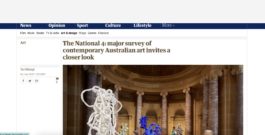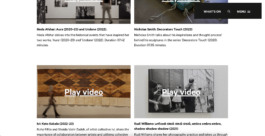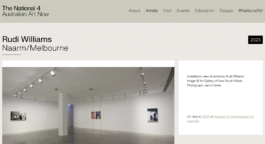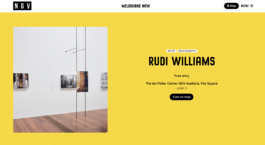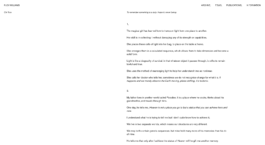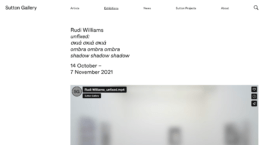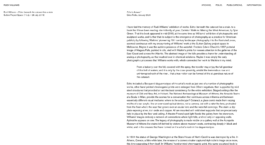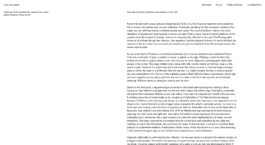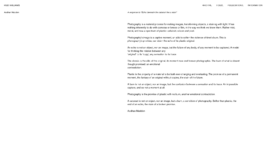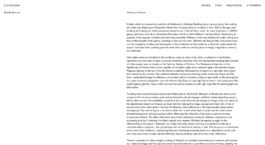
Hidden within the warren-like corridors of Melbourne’s Nicholas Building sits a reprieve above the rustling din of the city. Stepping off Swanston Street into the glass domed corridors of this 1920’s Chicago style building and taking one of the precarious elevators up to the 6th floor, suite 18, leads wayfarers to CAVES gallery and most recently, in November/December 2016, to Rudi Williams’ exhibition Echo. Embracing all aspects of the spaces’ confines and brimming possibility, Williams’ work truly inhabits the walls, ceiling and floor of this beautiful little gallery, needing no less and no more. Williams has thoughtfully considered every corner, irregularity, window and impression in the production of this exhibition and yet her work makes the space more than itself, pushing past the solid white walls to a liminal place of image, imagination, memory and reflection.
Only eight works are installed in this exhibition, each an echo of the other, a collection of similarities, repetitions and moments of déjà vu across continents and time. First, the handprinted photographic portrait of a blue jasper vase on display at the National Gallery of Victoria. This Wedgwood depiction of the Apotheosis of Homer hides under a gentle veil of gallery lights and uncleaned glass, the delicate winged Pegasus figurine at the top of the lid almost completely obliterated by the glare of a spotlight and erased from history by the camera. The patterned streaks of previous cleaning smear across the image and the form, a splendid homage to reflection, obfuscation and the camera’s ability to layer both on the same plane to create something altogether new and otherworldly. Eight circular light flares hover in the background like eight lingering ghosts, traces of the camera lens and its interaction with light long after the photograph has been taken.
Travelling from ancient Greece and present Melbourne to the Kremlin Museum in Russia, the next work is unique in both its documentary style and by being the only photograph exhibited clearly depicting people. All the other works in this exhibition could be from a time when human beings no longer exist, a museum to the abandoned objects and traces we leave behind; making this image unusual and important. A line of people wait at the ticket desk of the Kremlin Museum, their reflections in the impenetrable glass barrier staring back. The central figure, a woman in white with a soft white hijab or scarf over her head, leans forward talking to an unknown person within. Strangely the reflection of her face is cast into intense, anonymous shadow. The other reflections around her misbehave, looking in different directions or not appearing at all as if rebelling from their original counterparts. Williams transports us again to the otherworldly, to the place in-between the image and reality where anything is possible but nothing is captured without purpose... though perhaps with an element of chance or fate. This image is a counterpoint to the rest of the exhibition, a balancing influence that brings humanity back to an abandoned world, and yet, if you look close enough, ghosts still linger staring defiantly back at us from their reflections.
There is a question in these images, a string of thought conceivably commenting on museums and access, our cultural heritage and the real and unseen barriers between us and these objects of history, fighting the pull of time. Williams’ next photograph takes us inside the Kremlin Museum to glimpse a single object: a beautifully ornamented halo. This halo, called a venet, was made to embellish and adorn icons, generally icons of religious figures. The venet depicted here was most likely made to decorate an icon of the Virgin Mary. What is remarkable about this ornately jewelled crown, is the negative space it frames. Removed from its image this halo adorns an absence, a lack of purpose, it becomes a signifier cut off from its meaning, decorating an invisible abyss.
Absences are repeated across the exhibition in three delicately produced daguerreotypes and an accordion collection of postcards. The daguerreotypes, one of the first successful photographic processes, and the postcards, images with the purpose of travel, both depict a series of photographs taken within the Vatican Museum. These images are of the velvet lining of old display cases in the museum which have become bleached by light and age. With time the velvet has faded around the crosses, statues, triptychs and carvings kept in these cases, miraculously creating permanent shadows of objects long since removed, as though the time contained within has idled. Peering into the absences immortalised with these cases, the viewer is once again placed opposite a glass barrier of a display case, as though this glass is the embodied representation of the invisible camera lens dividing us from the frame. In the photographed glass, we can see reflections of the imaginary world behind us, in one instance the photographer herself, and in the glass of the daguerreotypes we see reflections or the real world behind us. Echo in the sense of this exhibition, therefore has two opposing but intertwined meanings. It is both the fertile complications of reflection and reproduction, and the barren but equally suggestive absenteeism of trace and loss. Echo is equally concealing and revealing, absence and presence, amnesia and memory.
Placed between the black and white photographs of the Kremlin Museum and daguerreotypes of the Vatican Museum, Williams points the camera towards the ceiling of Versailles. Under repair, the opulent ceiling is littered with small white squares which look suggestive of digital pixilation. An analogue photograph of a historical monument hinting at the digital imaging making processes of the present. The frescos on the ceiling are missing ad hock bits of information hidden under small ambiguous squares, another illustration of concealment and obfuscation in the world around us. In flipping the viewer’s perspective, Williams turns our gaze upwards to CAVES’ gallery ceiling and the most remarkable part of this exhibition: an overhead installation of two large acrylic panels titled Lethe. Taking the image back towards the real, Williams recreates the glass cabinets, display cases and windows she has photographed in an installation of acrylic which mirrors the entire exhibition back on itself. Reflections within reflections circle in on each other in a replicating dance, the patterned streaks from Apotheosis of Homer are emulated in the marks left on unpolished acrylic, like water, an ethereal river running above the exhibition below. The title Lethe aptly being the Greek word for oblivion, forgetfulness or concealment, and the name of one of the five rivers of the Greek underworld.
To end where we began, the last work in this exhibition returns us home to the National Gallery of Victoria (NGV). A photograph taken of two interior mirrors in the NGV International building, show the reflections of some vases and objects on display. Yet these reflections are dark and indiscernible, more like shadows left in velvet at the Vatican Museum, than true copies of the original objects. Williams pulls us, once again, between the echo of replica and the echo of absence.
An echo chamber in music is an enclosed space for producing the reverberation of sound, in a similar sense, Williams has transformed the enclosed room of CAVES into a space for the reverberation of the image. Site-specific in its consideration, this exhibition repeats and reflects not only in the photographs taken but through the mirroring of the exhibition itself in the acrylic ceiling. From the obscuring reflections over the Apotheosis of Homer, the Kremlin Museum ticket booth, and the NGV windows; to the trace absences demonstrated by Russian artefacts, Vatican velvet and the patched Versailles ceiling; Williams illustrates the complexities of echoes as reflective and concealing, equally loss and gain. This body of work therefore tests our understanding of the image, reality, the document, history, memory, and time, transporting us to somewhere indeterminate, somewhere in-between.
- Michelle Mountain

Hidden within the warren-like corridors of Melbourne’s Nicholas Building sits a reprieve above the rustling din of the city. Stepping off Swanston Street into the glass domed corridors of this 1920’s Chicago style building and taking one of the precarious elevators up to the 6th floor, suite 18, leads wayfarers to CAVES gallery and most recently, in November/December 2016, to Rudi Williams’ exhibition Echo. Embracing all aspects of the spaces’ confines and brimming possibility, Williams’ work truly inhabits the walls, ceiling and floor of this beautiful little gallery, needing no less and no more. Williams has thoughtfully considered every corner, irregularity, window and impression in the production of this exhibition and yet her work makes the space more than itself, pushing past the solid white walls to a liminal place of image, imagination, memory and reflection.
Only eight works are installed in this exhibition, each an echo of the other, a collection of similarities, repetitions and moments of déjà vu across continents and time. First, the handprinted photographic portrait of a blue jasper vase on display at the National Gallery of Victoria. This Wedgwood depiction of the Apotheosis of Homer hides under a gentle veil of gallery lights and uncleaned glass, the delicate winged Pegasus figurine at the top of the lid almost completely obliterated by the glare of a spotlight and erased from history by the camera. The patterned streaks of previous cleaning smear across the image and the form, a splendid homage to reflection, obfuscation and the camera’s ability to layer both on the same plane to create something altogether new and otherworldly. Eight circular light flares hover in the background like eight lingering ghosts, traces of the camera lens and its interaction with light long after the photograph has been taken.
Travelling from ancient Greece and present Melbourne to the Kremlin Museum in Russia, the next work is unique in both its documentary style and by being the only photograph exhibited clearly depicting people. All the other works in this exhibition could be from a time when human beings no longer exist, a museum to the abandoned objects and traces we leave behind; making this image unusual and important. A line of people wait at the ticket desk of the Kremlin Museum, their reflections in the impenetrable glass barrier staring back. The central figure, a woman in white with a soft white hijab or scarf over her head, leans forward talking to an unknown person within. Strangely the reflection of her face is cast into intense, anonymous shadow. The other reflections around her misbehave, looking in different directions or not appearing at all as if rebelling from their original counterparts. Williams transports us again to the otherworldly, to the place in-between the image and reality where anything is possible but nothing is captured without purpose... though perhaps with an element of chance or fate. This image is a counterpoint to the rest of the exhibition, a balancing influence that brings humanity back to an abandoned world, and yet, if you look close enough, ghosts still linger staring defiantly back at us from their reflections.
There is a question in these images, a string of thought conceivably commenting on museums and access, our cultural heritage and the real and unseen barriers between us and these objects of history, fighting the pull of time. Williams’ next photograph takes us inside the Kremlin Museum to glimpse a single object: a beautifully ornamented halo. This halo, called a venet, was made to embellish and adorn icons, generally icons of religious figures. The venet depicted here was most likely made to decorate an icon of the Virgin Mary. What is remarkable about this ornately jewelled crown, is the negative space it frames. Removed from its image this halo adorns an absence, a lack of purpose, it becomes a signifier cut off from its meaning, decorating an invisible abyss.
Absences are repeated across the exhibition in three delicately produced daguerreotypes and an accordion collection of postcards. The daguerreotypes, one of the first successful photographic processes, and the postcards, images with the purpose of travel, both depict a series of photographs taken within the Vatican Museum. These images are of the velvet lining of old display cases in the museum which have become bleached by light and age. With time the velvet has faded around the crosses, statues, triptychs and carvings kept in these cases, miraculously creating permanent shadows of objects long since removed, as though the time contained within has idled. Peering into the absences immortalised with these cases, the viewer is once again placed opposite a glass barrier of a display case, as though this glass is the embodied representation of the invisible camera lens dividing us from the frame. In the photographed glass, we can see reflections of the imaginary world behind us, in one instance the photographer herself, and in the glass of the daguerreotypes we see reflections or the real world behind us. Echo in the sense of this exhibition, therefore has two opposing but intertwined meanings. It is both the fertile complications of reflection and reproduction, and the barren but equally suggestive absenteeism of trace and loss. Echo is equally concealing and revealing, absence and presence, amnesia and memory.
Placed between the black and white photographs of the Kremlin Museum and daguerreotypes of the Vatican Museum, Williams points the camera towards the ceiling of Versailles. Under repair, the opulent ceiling is littered with small white squares which look suggestive of digital pixilation. An analogue photograph of a historical monument hinting at the digital imaging making processes of the present. The frescos on the ceiling are missing ad hock bits of information hidden under small ambiguous squares, another illustration of concealment and obfuscation in the world around us. In flipping the viewer’s perspective, Williams turns our gaze upwards to CAVES’ gallery ceiling and the most remarkable part of this exhibition: an overhead installation of two large acrylic panels titled Lethe. Taking the image back towards the real, Williams recreates the glass cabinets, display cases and windows she has photographed in an installation of acrylic which mirrors the entire exhibition back on itself. Reflections within reflections circle in on each other in a replicating dance, the patterned streaks from Apotheosis of Homer are emulated in the marks left on unpolished acrylic, like water, an ethereal river running above the exhibition below. The title Lethe aptly being the Greek word for oblivion, forgetfulness or concealment, and the name of one of the five rivers of the Greek underworld.
To end where we began, the last work in this exhibition returns us home to the National Gallery of Victoria (NGV). A photograph taken of two interior mirrors in the NGV International building, show the reflections of some vases and objects on display. Yet these reflections are dark and indiscernible, more like shadows left in velvet at the Vatican Museum, than true copies of the original objects. Williams pulls us, once again, between the echo of replica and the echo of absence.
An echo chamber in music is an enclosed space for producing the reverberation of sound, in a similar sense, Williams has transformed the enclosed room of CAVES into a space for the reverberation of the image. Site-specific in its consideration, this exhibition repeats and reflects not only in the photographs taken but through the mirroring of the exhibition itself in the acrylic ceiling. From the obscuring reflections over the Apotheosis of Homer, the Kremlin Museum ticket booth, and the NGV windows; to the trace absences demonstrated by Russian artefacts, Vatican velvet and the patched Versailles ceiling; Williams illustrates the complexities of echoes as reflective and concealing, equally loss and gain. This body of work therefore tests our understanding of the image, reality, the document, history, memory, and time, transporting us to somewhere indeterminate, somewhere in-between.
- Michelle Mountain
